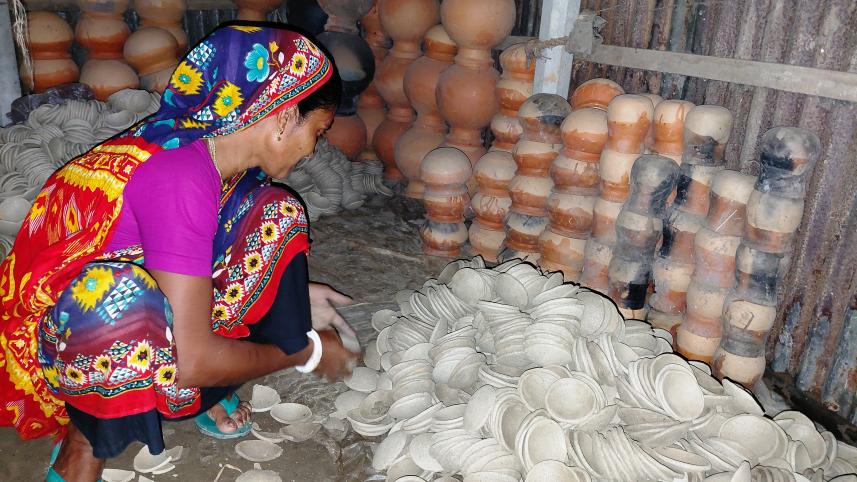Potters rush to light Diwali as 12cr lamps take shape in northern villages

As the Hindu festival of Diwali approaches on October 20, the pottery villages of northern Bangladesh are buzzing with activity and anticipation. Across Lalmonirhat, Rangpur, Gaibandha, Nilphamari, and Kurigram, nearly 3,000 potter families are working day and night to produce millions of earthen lamps, locally known as 'diya', hoping the festive season brings much-needed prosperity.
For over a month, hands have been stained red with clay as families race to meet soaring demand. Each household is preparing 20,000 to 80,000 lamps, and potters estimate that at least 12 crore will be needed to light Diwali in the Rangpur region alone.

In local markets, 100 lamps are selling for Tk 150–160 (standard quality), Tk 220–250 (medium), and Tk 300–350 (fine finish). But while sales prospects look strong, potters say rising prices of clay and firewood have sharply increased production costs compared to previous years.
"I've prepared around 80,000 lamps this year," said Mohan Chandra Pal, 55, from Kumarpara village in Rangpur's Kaunia upazila.
"Wholesalers are coming from different areas to buy. Each of the 60 families here has prepared between 20,000 and 80,000 lamps. We're hopeful this year will be profitable."

In Lalmonirhat's Aditmari upazila, Bishnu Chandra Pal, 45, described the meticulous craft behind each lamp.
"We make small, medium, and large lamps. First we mould and sun-dry them, then bake them in kilns. It now costs Tk 30–70 to produce 100 pieces. Prices have gone up everywhere — clay, wood, everything."
He has already finished 50,000 lamps, and says all 40 pottery families in his village are expecting a good season.
In Kurigram's Rajarhat upazila, 70-year-old Subendu Nath Pal said, "We can fire 3,000 to 5,000 lamps at a time. The kiln burns from dawn to dusk. After 12 hours of cooling, they come out ready for sale."

His family has already made 75,000 lamps this year.
Not everyone produces, some have turned traders.
"I buy directly from potters and sell across markets," said Nityananda Pal, 50, from Phulbari upazila. "My target is to sell three lakh lamps this year."
For many families, Diwali is nothing short of an economic lifeline.
"Every year, on Diwali alone, a family can earn Tk 60,000 to Tk 2 lakh," said Jogen Chandra Pal, 60, from Lalmonirhat sadar. "That income helps us survive the lean months."
The demand is massive. According to the Puja Udjapan Parishad, there are around 2.5 lakh Hindu families in the five districts of Rangpur region. Each buys 300 to 800 lamps to light homes, temples, cremation grounds, and business establishments.
"The diya is the heart of Diwali," said Pradip Roy, secretary of Lalmonirhat Puja Udjapan Parishad.
"Lighting the lamp is not just celebration, it is prayer. It is a remembrance. It is hope."
Diwali lamps Bangladesh, Rangpur potters Diwali, clay lamp production Lalmonirhat, Hindu festival preparations Bangladesh, earthen lamp market




 For all latest news, follow The Daily Star's Google News channel.
For all latest news, follow The Daily Star's Google News channel.
Comments